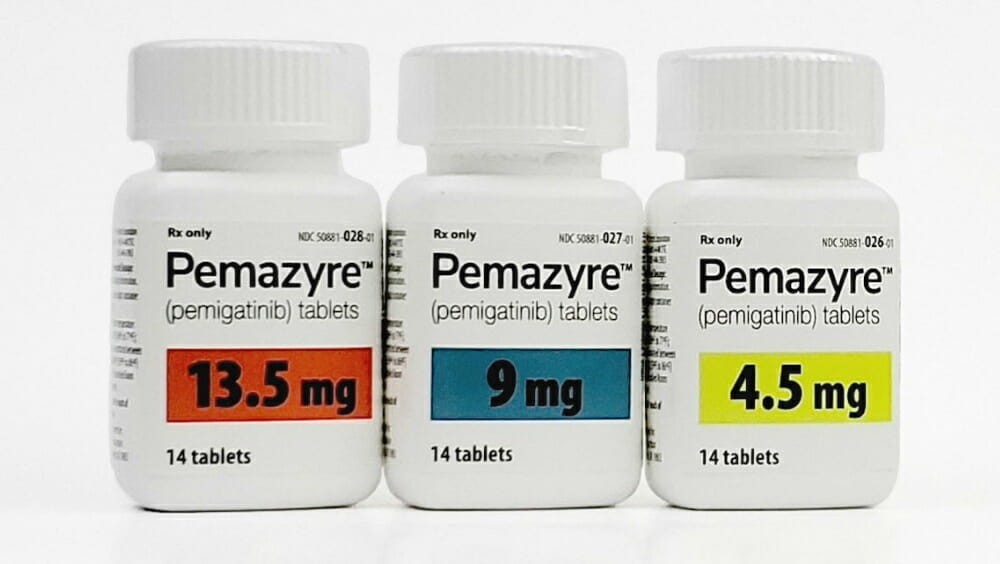
Contents
- 1 Pemazyre
- 1.0.1 Warnings
- 1.0.2 What are the side effects of Pemazyre?
- 1.0.3 What is the dosage for Pemazyre?
- 1.0.3.1 Patient Selection
- 1.0.3.2 Recommended Dosage
- 1.0.3.3 Dosage Modification for Adverse Reactions
- 1.0.3.4 Dosage Modification for Concomitant Use with Strong or Moderate CYP3A Inhibitors
- 1.0.3.5 Recommended Dosage for Severe Renal Impairment
- 1.0.3.6 Recommended Dosage for Severe Hepatic Impairment
- 1.0.3.7 Recommended Dosage for Myeloid/Lymphoid Neoplasms with FGFR1 Rearrangement
Pemazyre
Pemazyre is a prescription medicine used to treat adults with bile duct cancer (cholangiocarcinoma) that has spread or cannot be removed by surgery:
- who have already received previous treatment and
- whose tumor has a certain type of abnormal "FGFR2" gene.
Your healthcare provider will test your cancer for a certain type of abnormal FGFR2 gene and determine if Pemazyre is right for you.
Pemazyre is also indicated for the treatment of adults with relapsed or refractory myeloid/lymphoid neoplasms (MLNs) with fibroblast growth factor receptor 1 (FGFR1) rearrangement.
Pemazyre’s safety and effectiveness in children are unknown.
Warnings
- Pemazyre may cause Retinal Pigment Epithelial Detachment (RPED), which may cause symptoms such as blurred vision, visual floaters, or photopsia.
- Pemazyre may cause hyperphosphatemia leading to soft tissue mineralization, cutaneous calcification, calcinosis, and non-uremic calciphylaxis. Increases in phosphate levels are a pharmacodynamic effect of Pemazyre.
What are the side effects of Pemazyre?
- Eye problems. Certain eye problems are common with Pemazyre but can also be serious. Eye problems include dry eye or inflamed eyes, inflamed cornea, increased tears, and retinal disorder. You will need to see an eye specialist for a complete eye exam before starting Pemazyre and regularly throughout treatment.
- Use artificial tears or substitutes, hydrating or lubricating eye gels as needed to prevent or treat dry eyes.
- Contact your healthcare provider immediately if you experience any changes in vision, such as blurred vision, flashes of light, or seeing black spots. Seek immediate medical attention from an eye specialist.
The most common side effects of Pemazyre are:
- hair loss
- diarrhea
- nails separating from the nail bed or poor nail formation
- fatigue
- changes in sense of taste
- nausea
- constipation
- mouth sores
- dry eyes
- dry mouth
- decreased appetite
- vomiting
- joint pain
- abdominal pain
- low phosphate levels in the blood
- back pain
- dry skin
This is not an exhaustive list of possible side effects. For more information, consult your healthcare provider or pharmacist.
Contact your doctor for medical advice about side effects. You may also report side effects to the FDA at 1-800-FDA-1088.
What is the dosage for Pemazyre?
Patient Selection
Select patients for the treatment of locally advanced or metastatic cholangiocarcinoma with Pemazyre based on the presence of an FGFR2 fusion or rearrangement detected by an FDA-approved test.
Information on FDA-approved tests for the detection of FGFR2 fusion or rearrangement in cholangiocarcinoma is available at http://www.fda.gov/CompanionDiagnostics.
Recommended Dosage
- The recommended dosage of Pemazyre is 13.5 mg orally once daily for 14 consecutive days followed by 7 days off therapy, in 21-day cycles. Continue treatment until disease progression or unacceptable toxicity occurs.
- Take Pemazyre with or without food at approximately the same time every day.
- Swallow tablets whole. Do not crush, chew, split, or dissolve tablets.
- If the patient misses a dose of Pemazyre by 4 or more hours or if vomiting occurs, resume dosing with the next scheduled dose.
Dosage Modification for Adverse Reactions
- The recommended dose reductions for adverse reactions are provided in Table 1.
Table 1: Recommended Dose Reductions for Pemazyre for Adverse Reactions
| Dose Reduction | Recommended Dosage |
| First | 9 mg once daily for first 14 days of each 21-day cycle |
| Second* | 4.5 mg once daily for first 14 days of each 21-day cycle |
| * Permanently discontinue Pemazyre if unable to tolerate 4.5 mg once daily. | |
- The recommended dosage modifications for adverse reactions are provided in Table 2.
Table 2: Recommended Dosage Modifications for Pemazyre Adverse Reactions
- If asymptomatic and stable on serial examination, continue Pemazyre.
- If symptomatic or worsening on serial examination, withhold Pemazyre.
- If asymptomatic and improved on subsequent examination, resume Pemazyre at a lower dose.
- If symptoms persist or examination does not improve, consider permanent discontinuation of Pemazyre based on clinical status.
Dosage Modification for Concomitant Use with Strong or Moderate CYP3A Inhibitors
Avoid concomitant use of strong and moderate CYP3A inhibitors with Pemazyre. If unavoidable:
- Reduce Pemazyre dosage from 13.5 mg to 9 mg.
- Reduce Pemazyre dosage from 9 mg to 4.5 mg.
If concomitant use of a strong or moderate CYP3A inhibitor is discontinued, increase the Pemazyre dosage (after 3 plasma half-lives of the CYP3A inhibitor) to the dosage used prior to starting the inhibitor.
Recommended Dosage for Severe Renal Impairment
- The recommended dosage of Pemazyre for patients with severe renal impairment (eGFR estimated by MDRD 15 to 29 mL/min/1.73 m^2) is 9 mg orally once daily for 14 consecutive days followed by 7 days off therapy, in 21-day cycles.
Recommended Dosage for Severe Hepatic Impairment
- The recommended dosage of Pemazyre for patients with severe hepatic impairment (total bilirubin > 3 × ULN with any AST) is 9 mg orally once daily for 14 consecutive days followed by 7 days off therapy, in 21-day cycles.
Recommended Dosage for Myeloid/Lymphoid Neoplasms with FGFR1 Rearrangement
- The recommended dosage of Pemazyre is 13.5 mg orally once daily on a continuous basis. Continue treatment until disease progression or unacceptable toxicity occurs.


